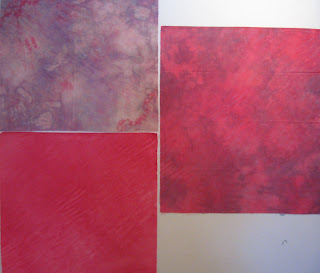Remember when you look at these pictures that this class was not designed to produce finished products. It was a class designed to teach different techniques of improvisational screen printing. That was very freeing in that it allowed us to experiment and "play" without the pressure of producing something with all the elements of good design. We weren't afraid to try out the "what if" scenario even if we thought it might fail.
We covered lots and lots of ways to use a screen to print images onto fabric. We transferred images using watercolor crayons. The image was colored onto the screen and a gel medium was used to bind the color to the fabric. This is one of mine. As much as I love the color I can get, I don't think I would use this method for my type of work; because the gel medium changes the hand of the fabric too much.
This next one is another one of mine. We printed the image until the color was pretty much exhausted (which in this case was three prints). My first print is on the bottom, the second in the middle, and the last on top. Generally, I found that the second print was the best. This one reminded me of the Kandinsky paintings I like so much.
This example belongs to another student in the class. I really liked the way she placed the images on the fabric.
We also used flour paste on the screens. We covered the screen with flour paste, let it dry, and etched lines into it. We discovered that we could etch lines from the back AND the front of the screen, which opened the door to writing text without it coming out backwards. We were all amazed at the quality of line we could get with the flour paste.
Here, Jane is etching a design into the dried flour paste using a wooden skewer.
This is a little experiment I did. We were urged to put the flour on in a thin, even layer. I wondered what would happen if I put on a thick layer and used the holes, chips, and cracks in the flour as a design element. I was totally prepared for failure--and I thought it WAS a failure until another student added one of her designs over the top. That is when I saw the potential in something SO simple. (The black design was made with the really thick flour paste screen. The tan was my friend's design.)
You can see Jane's flour paste etching on the table. We used tempera paints for the class, so we didn't have to worry about the paint drying in the screens. During the class we discovered that the brand of tempera paints we used (Sargent Art/Art-Time) was somewhat permanent. Jane heat set her design, washed it out, put it in the dryer, and found there was very little loss of line or color. She seemed very surprised (and excited) about that discovery.I've heard it said that, "You can't teach an old dog new tricks." Well, I found out that you CAN teach THIS old dog new tricks! Another thing I took away from this class is that I need to spend less time trying absolutely every new technique I can find and more time actually making some pieces that USE the techniques I have learned.
I have several more methods and pictures to share, so check back soon.



















































